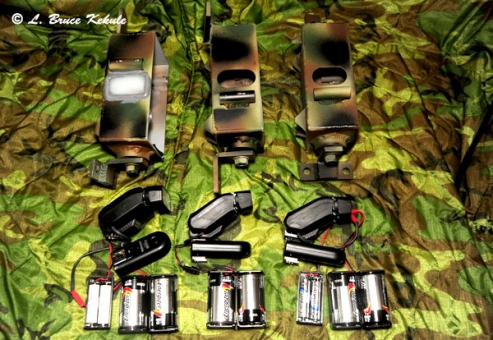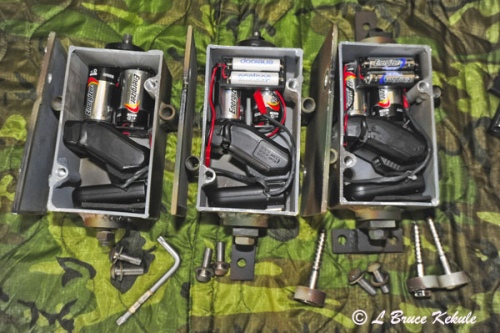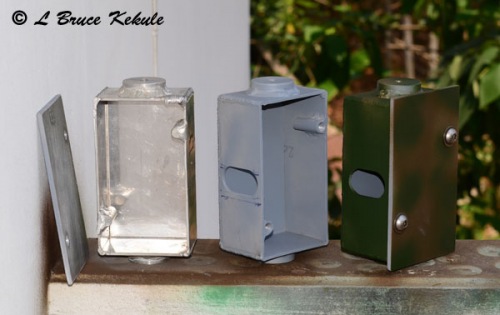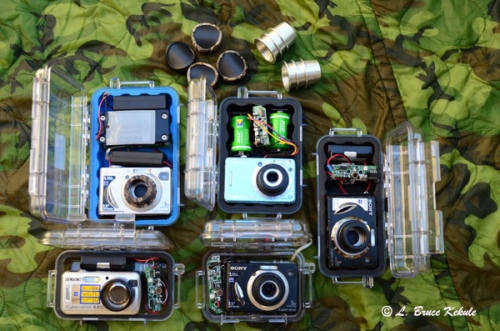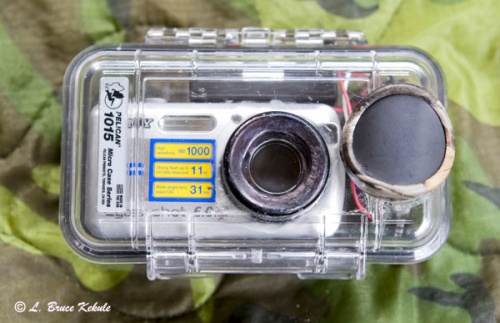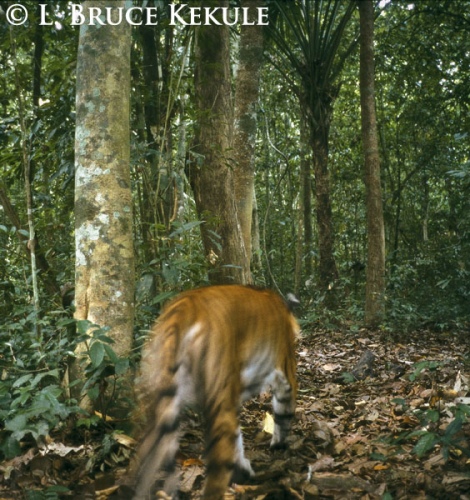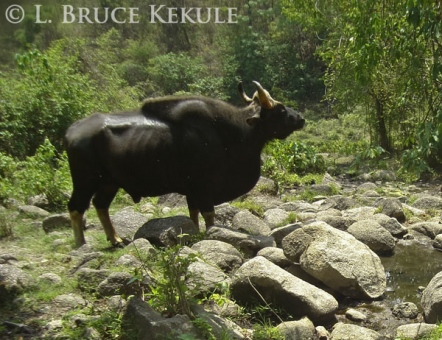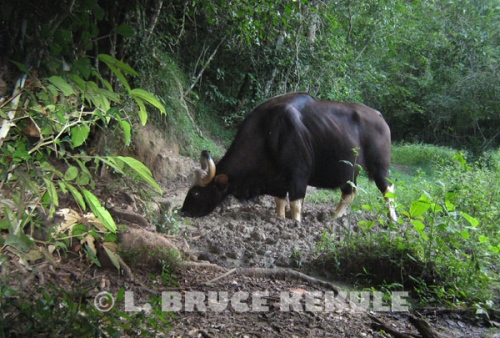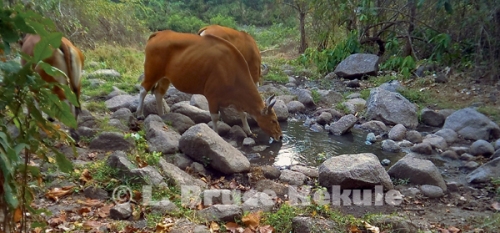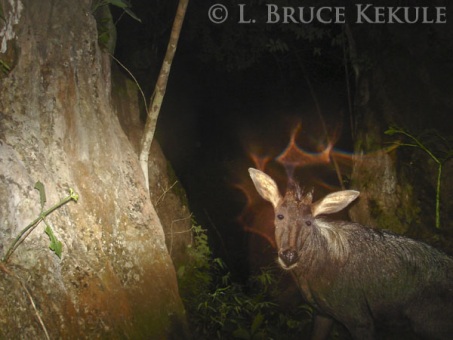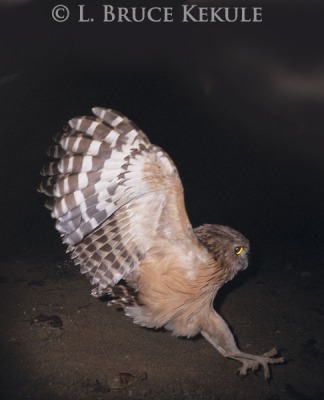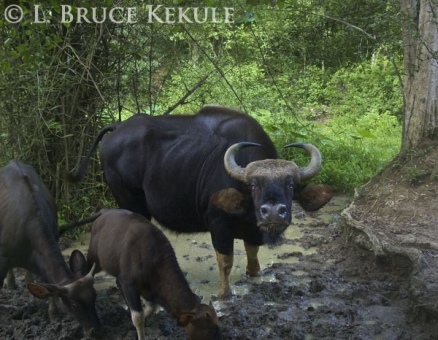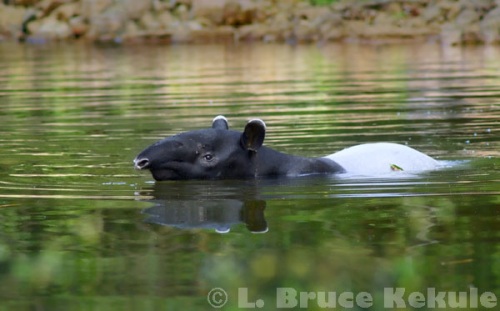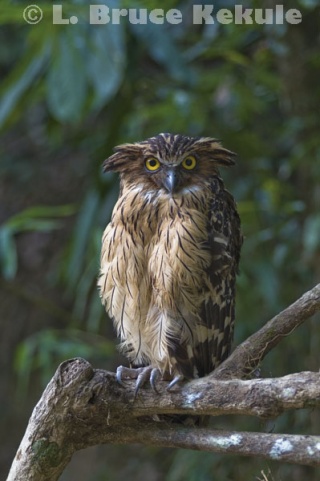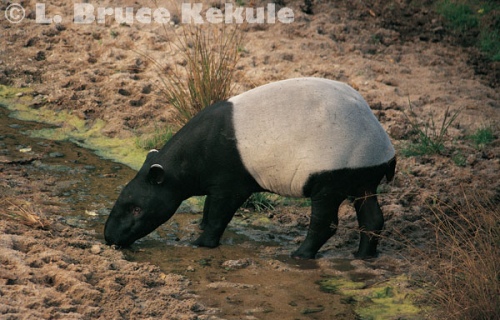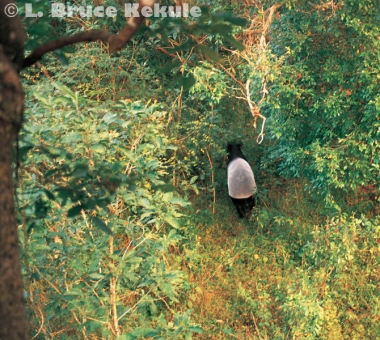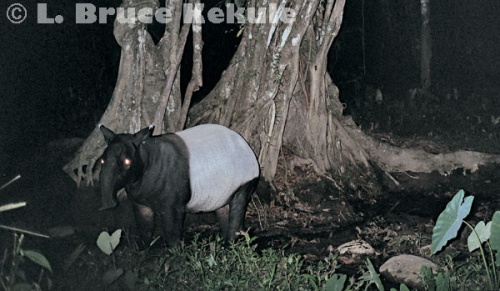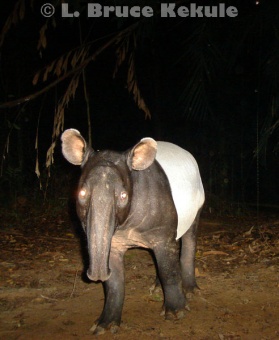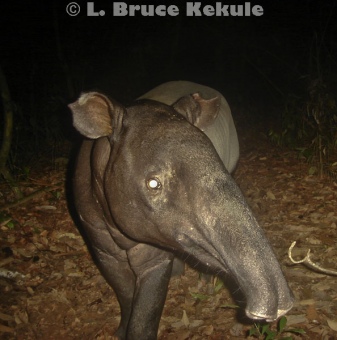Posts Tagged ‘infrared camera-trapping’
A new DSLR camera trap
A Canon 400D trail camera with three Canon 270EX speedlights
This DSLR camera trap has been in the making for over a year but with many great opportunities now for tiger, leopard and other interesting wildlife photographs, I decided to finish it off.
DSLR Canon trail camera components
Canon 400D and ‘elephant proof’ aluminum box
Canon flash components
Close-up of wireless flash units
Machining flash boxes at my machine shop in Chiang Mai
Flash boxes in the raw, with a primer coat and camouflage paint job
Wireless flash trigger external modification
This Canon camera and flash units were assembled into an infrared camera trap using aluminum housings made in my shop at home in Chiang Mai. The main object of this project is to use multiple flashes and get some really great wildlife shots from this DSLR. The system works very well and it will be interesting to see what comes out.
Next week, I’m on my way to my favorite wildlife sanctuary in Thailand: Huai Kha Khaeng. I will be setting this rig where I have captured several tigers and leopard plus sun bear, gaur, banteng, elephant and a host of other animals that visit this mineral deposit and water hole. It should be interesting and I will post set-up and photos as soon as I get some (hopefully a tiger).
LBK ‘Clear View’ camera trap project
Building a modern digital camera trap
LBK ‘clear-view’ camera traps parts assembled
Recently, I wanted to up-grade my camera trap fleet using ‘Pelican’ cases available here in Thailand consisting of the 1010, 1015, 1020, 1030 and 1040 ‘Micro’ series. All of them were clear and I thought I would just coat them with camouflage paint when finished. After studying and collecting cameras, boards and externals, I began building this series of trail cameras around these clear boxes.
Camera trap #1 in the ‘clear view’ series
A Sony S600/Pelican 1015/SSII/2 AAs
Then it hit me. The practical aspect of this build is no need to drill an extra hole for the flash and just let the camera’s flash shoot straight through the box. A lens snorkel is used in every build and so there is no flash-bleed with the clear boxes.
I sourced all the components including Sony cameras depending on which Pelican case was used including a S600, W55 and several W5/7s. The infrared board is the SS1 & SSII plus one Yeticam board. Snorkels were machined from aluminum and a rubber gasket was made from Permatex black silicon sealant. SnapShotSniper ‘HPWAs’(High Performance Wide Angle fresnel lens) are used with one exception (the W5/1040/Yeticam using a standard wide angle lens).
Completed Sony S600/Pelican 1015/SSII/2 AAs
At most of my camera trap sites in Thailand’s protected areas, an aluminum box fitted around the Pelican case to protect it is an absolute must primarily from wild elephants, but also from theft. I use several 3” stainless lag bolts inside the box screwed into the tree (preferably dead) in conjunction with a ‘Python locking cable’ in 5/16” or 3/8” diameters. A 3mm aluminum alloy faceplate drilled for the lens, flash and sensor holes is bolted on to the front using stainless steel ‘power torque’ 10mm machine screws.
Power torque 10mm machine screws and wrench
This system has defeated many inquisitive jumbos who can destroy traps with extreme strength. These aluminum boxes are so firmly attached to the tree they just leave them alone after awhile. A friend of mine recently had three camera trap units with Python locking cables completely ripped off the tree and smashed by wild elephants in Thap Lan National Park in eastern Thailand because he used no lag bolts.
Fortunately for me, there is a custom motorcycle welding shop close to my house that offers ‘Tig’ welding of aluminum and I can have custom dimensions made up to fit any one of the Pelican cases I use. I do all the machining required in my shop at home. Aluminum is much better than steel being more lightweight and rust proof. Also, it is much easier to machine then tough old steel.
Completed camera trap and ‘elephant box’
I cut off the belt loops on the Pelican to make the boxes slightly smaller. I then do a 3D camouflage job on the outside box with black silicone sealant and paint with flat brown, tan and/or green to suit different tree bark colors and patterns. Pre-scouting of camera trap areas and photographing the trees to match-up the bark pattern can be accomplished.
Another aspect of using clear Pelican boxes is I can then use them in wildlife photography and camera trap workshops I occasionally do for Kasetsart University and the private sector in Bangkok. Camera trapping in Thailand with all its exotic animals is amazing and this series of clear boxes are my 4th generation camera traps (1st – generation were film cameras in aluminum boxes, 2nd – digital cameras in aluminum boxes and 3rd – Standard Pelican cases in aluminum boxes).
I hope this might help some people with bear problems in North America and elephant trouble elsewhere with access to ‘tig-welding’ equipment and a machine shop. I have completed the first trap shown here and will post the others to follow. This one is my favorite: A Sony S600/SS2/1015 with a single AA external. This small camera trap is just right for my day pack.
I will be setting this one next month in Huai Kha Khaeng Wildlife Sanctuary, a World Heritage Site situated in western Thailand. I now have ten digital camera traps and three video traps working in this forest and will post photos and videos as soon as I get back out from the field. I am extremely lucky to be able to work here.
Goral in Mae Lao-Mae Sae Wildlife Sanctaury – Northern Thailand
From June to August 2011, I set a Bushnell Trophy Cam on video mode at the top of ‘Mon Liem’ mountain in the sanctuary. After collecting the camera, many clips of goral were taken, both during the day and at night. This is just a few of those clips.
Asian Wild Dogs in Mae Lao-Mae Sae Wildlife Sanctuary: Part Two & Three
Wild dogs pass a Bushnell Trophy Cam a few days later:
These videos once again demonstrate Thailand’s beautiful and amazing natural heritage, and the fact these carnivores are still thriving in the North formally thought to be extinct.
Wildlife Candid Camera-Update: Photographing rare creatures with modern digital wizardry
Trail cameras catch Thailand’s cryptic wildlife
Indochinese tiger camera trap abstract
Camera trapping has been around for over a century when George Shiras III making history used the first flashlight camera triggered by trips wires in 1906. In the late twenties, two other men, F.M. Chapman and F.W. Champion, used pressure plates to activate their cameras. National Geographic and other magazines published many photographs from these early pioneers’ work.
In the 1970s, the first commercial camera trap was produced by TrailMaster.com using ‘active infrared’ to control the cameras followed by CamTrakker.com that used ‘passive infrared’ controlled traps to set off their cameras. Both companies incorporated simple point-and-shoot film cameras from Olympus and Yashica to capture photographs of wildlife.
Asiatic sun bear in Kaeng Krachan
Active infrared uses a beam between two separate units (transmitter and receiver hooked to a camera) and when the beam is broken, the camera is tripped. One the other hand, passive infrared detects motion within a given area covered by the sensor and will trip the camera when movement is detected (much like the sensors above automated doors in shopping malls and convenience stores). Both systems have merit and used in the right situation work equally well.
These first early-production units were designed and used by hunters in America to scout areas for deer, turkey and bear prior to hunting season. This in turn helped them to indentify trophy animals and movements of game in a given forest.
Gaur bull at a waterhole in Huai Kha Khaeng
It was not long before wildlife researchers found camera traps could also benefit their work with a photograph, plus the time and date, allowing them to create an extensive database of the animals living is a certain area. Behavior, presence/absence and other aspects of mammals, birds and reptiles are recorded.
Gaur cow at a mineral deposit in Kaeng Krachan
Wildlife photographers have also used camera traps to capture images of rare, endangered or cryptic creatures. Some have used simple camera-traps but others have incorporated high-end SLR or DSLR cameras with several flashes.
Banteng bull and forest flies in Huai Kha Khaeng
Steve Winter with National Geographic Magazine got an amazing photo of a snow leopard using a Canon DSLR and three Nikon flashes that won the Wildlife Photographer of the Year contest in 2008. The following year, a camera trap photograph of a wolf jumping over a fence won first prize but was later disqualified as the carnivore was domesticated and trained to jump. The organizers of this prestigious event should put camera trapping into its own category.
Banteng cows at a waterhole in Huai Kha Khaeng
The homebrew ‘Game Cam’ or ‘Trail Cam’ as it is now known by its users in the U.S.A. is a unique device with some units very high tech in its features, yet simple to operate and enjoy for just about anyone that has an interest in capturing photographs of wildlife.
Wild water buffalo caught by the Huai Kha Khaeng
The popularity of these cameras has grown at a fast pace over the last few years and opened up a number of usage possibilities to the users. There is also a huge ‘home-brew’ market for the do-it-yourself enthusiast plus the ready-made models that are available for those with a larger budget and no time to build one.
Serow in Sai Yok reserved forest
Camera traps have become very sophisticated and most now use some form of digital camera incorporated into the housing. There are now many companies producing them for less than one hundred U.S. dollars up to $900 or more. Some are fair and some quite good but many are not suitable for the tough conditions found in Thailand’s forests, especially the lower cost models.
Sambar stag in Khlong Saeng
As a wildlife photographer and due to the high cost of buying and importing commercial models into Thailand, I decided to produce my own camera traps. In the beginning, I used passive infrared circuit boards obtained from ‘Radio Shack’ in the U.S and had my close friend Yutdhana Anantavara from Chiang Mai, an electrician working offshore in the Gulf of Thailand, to hook-up the delicate electronics and modify some simple ‘point and shoot’ film cameras (Olympus and Canon).
To stand-up to the rigorous conditions in a Thai forest where moisture, invading insects and elephants can destroy plastic bodied camera traps, I designed and built the housings from aluminum at my machine shop in Chiang Mai.
Buffy fish-owl landing by the Phetchaburi River
A local welder TIG welded-up the box and I machined it flat. By using silicon sealant available at most hardware stores between the box and the flat faceplate, and by using large 10mm machine screws to get a tight seal, sealing is 100 percent. These have defeated many inquisitive elephants.
A small bag of silica gel (desiccant) is inserted in the box to protect the delicate circuit boards, cameras and film from moisture. I tested them on feral cats that walked on a wall at the back of my shop with some good results. These early models worked very well and I then decided to deploy them in the forest.
Feral cat camera-trapped behind my shop in Chiang Mai
In mid-2003, I set six camera traps in Sai Yok National Park in western Thailand by wildlife trails and waterholes. Every month, I would visit the traps and change film, batteries and desiccant. After four months, I finally got my first tiger, and then a second cat a few days later up on a 600-meter ridgeline. All the hard work and expense finally paid off.
It was the beginning of a program to catch the tiger on film. Other animals caught in Sai Yok were elephant, sambar, barking deer, wild dog, wild pig, serow and stumped-tailed macaque. I even managed to catch a water monitor on one camera.
Indochinese tiger by the Phetchaburi River
Even some poachers and hunting dogs were captured on film. One of those original film cameras is still working in the field and I named it ‘Tiger Cam’ as it caught my second tiger.
I then moved down to Kaeng Krachan National Park in the Southwest where I spent three years camera trapping wildlife to establish a presence/absence program in conjunction with Worldwide Fund for Nature (WWF-Thailand provided funding), and the Department of National Parks granted permission.
Gaur cow and calves in a mineral deposit in Kaeng Krachan
At that time, many tigers and leopards plus loads of prey species were thriving by the Phetchaburi River and a few of its tributaries, and many photographs were obtained over the course of the survey indicating a healthy ecosystem. Both prey and predator were living in natural harmony. I shut down the program after poachers stole three units near the headwaters of the river that was both costly and disappointing.
Sometime in 2007, my good friend Chris Wemmer, the Camera Trap Codger, who is now retired from the Smithsonian Institute, was the first person to tell me about a new company in the US producing infrared circuit boards and other accessories for the home-brew digital camera trap market. The company is Pixcontroller.com. Unfortunately, they no longer offer parts but now sell complete units with digital camera and video.
Asian wild dogs by the Phetchaburi River
A quick look on the Internet, and several companies offering boards and components to build ‘homebrew’ trail cameras are on-line. The best and the most reliable are boards from Snapshotsniper.com and Yeticam.com. The list for complete units is long and is best searched on the web.
I finally purchased some of the new high-tech boards and made-up some new traps using Sony ‘point-and-shoot’ digital cameras. These were modified by EDI, a company based in Bangkok to work with the electronic boards. The aluminum cases remained the same as the early production units as the best option for durability, and against moisture and elephants.
Tusker camera trapped at a waterhole in Huai Kha Khaeng
The first units were set-up at several mineral deposits deep in the forest of Kaeng Krachan National Park over a three-month period from October to December 2008. Animals digitally captured were tiger, elephant, gaur, sambar and muntjac. One camera had over 300 captures in one month at a mineral lick of elephant and gaur.
I then moved down to Khlong Saeng Wildlife Sanctuary in Surat Thani, southern Thailand and in the first part of 2009, began a new program setting both film and digital camera traps deep in the interior. Elephants, gaur, tapir, wild pig, sambar, muntjac, golden cat and Argus pheasant were captured.
Giraffe caught in Samburu Game Reserve in Kenya, Africa
This year in September, I made a trip to Kenya, Africa and took two camera traps with me. Due to the strict regulations about exiting the safari vehicle, it was difficult to set them up. But at one location, I was able to install one by a game trail. In four hours, a giraffe and elephant passed the camera. It showed how well these cameras can record passing wildlife, and the giraffe photograph shown in the story is the best one.
LBK camera trap using Sony W7 with a ‘Yeticam.com’ infrared board
in aluminum case with ‘Python’ locking cable
I now have more than a dozen digital camera traps using primarily ‘Sony S600 and W7’ cameras. They have been the best and most durable due to the manual features like ISO and f-stop adjustments, and compatibility with the infrared boards. Picture quality with the ‘Carl Zeiss’ lens is very good in the daytime and quite good at night.
The latest craze for camera trappers is ‘infrared capture’. The photos however are a greenish black and white, but are quite good for identification and scientific work. This system is unseen by animals and reported not to disturb them as a conventional flash.
Poachers and dog camera trapped in Sai Yok National Park
Video is another option. I now have two ‘Sony Handy Cams’ set-up with ‘Lanc’ video infrared boards that work very well. One is for daytime only and the other set to ‘night-shot’ with an infrared filter over the video light. Both work together at the same location over the course of a month between battery changes and downloads. It is just another option for those needing wildlife images, whether stills or movie.
The modern digital camera trap has allowed me to capture/recapture many rare and cryptic creatures on their own time, and in their own habitat. As wild animals continue to disappear, more protection, research and understanding are needed to save the natural world.
It is my main priority in life to educate all levels of society on what the Thai nation still has in regards to wildlife and the protected areas, and the need for proactive response to all the dangers facing Mother Nature. We must act fast to illuminate these threats to the Kingdom’s natural world so present and future generations can see, enjoy and cherish this wonderful heritage.
The Asian Tapir – Living fossil and bizarre mammal
Odd-toed ungulate and strictly vegetarian
The Asian tapir still thrive in Thailand’s dense evergreen forests in the West and South
It was an amazing day in March 2005 near the headwaters of the Phetchaburi River deep in Kaeng Krachan National Park situated along the border with Burma in southwest Thailand. One morning, a buffy fish-owl found stuck in a fishnet was going into shock from hypothermia. I luckily saved this creature from certain death.
Asian tapir posing in the Phetchaburi River
The campfire was going well and I used it to warm up the bird of prey. When it could stand by itself, I placed it on a tree branch and then played wildlife photographer for a short while. I then left the confused animal in peace and it eventually flew across the river and disappeared into the forest. I felt good saving the owl. Under other circumstances, it might not have fared too well.
Buffy fish-owl saved from certain death
Later in the day as we were up-river and just about ready to turn back, a huge king cobra showed-up hunting for prey along the riverbank. I was able to catch a few photographs of the largest venomous snake in the world before it U-turned and disappeared into the forest.
King cobra hunting by the Phetchaburi River
That definitely got the blood flowing as I checked out my shots on my brand new Minolta D7 D-SLR digital camera, the first with anti-shake technology in the camera body. I shot off-hand and was getting some acceptable digital captures. When the smoke cleared, I had only two shots left on the card and decided not to delete any poor exposures as I felt nothing would show after the big snake.
Asian tapir swimming in the Phetchaburi River
It was about 4pm and the light was nice and warm as we headed back to camp more than an hour away. Just then, an Asian tapir bounced out of the forest and dived into the river. It submerged for a short time probably trying to evade a swarm of biting forest flies before surfacing and swimming towards us. I took a shot waiting for the ungulate to get closer. It stopped in the water about twenty meters away.
The tapir has very poor vision and it took a few seconds before the unusual creature saw five humans standing out in the open. Just as I snapped my last shot shown in the lead photo, it swam away and jumped back into the forest it had come from. Seeing one of nature’s remarkable animals, even though briefly, is the ultimate thrill for me.
I know I missed quite a few shots because of old age forgetfulness (not having spare memory cards), but then again, the two shots I captured were more than enough. I was thrilled to capture the world’s largest tapir in broad daylight offhand. If I used a tripod that day, I might have missed it. These creatures are mainly nocturnal and rarely seen during the day. This event was truly the beginning of a new dream and this tapir made the front cover of my third book Wild Rivers. It certainly was special for me, and is etched in memory.
In Thailand, photographing three separate species in one day is surely a rare occurrence as most animals are now tough to see and photograph, especially the tapir. It must have been something about saving the owl earlier in the day and the ‘spirits of the forest’ made up these magical sightings. I will never know. It had been a dream of mine to photograph a tapir in the Phetchaburi River in Kaeng Krachan National Park after seeing a painting in a book produced by the Tourist Authority of Thailand (TAT) about the park.
My first tapir from a tree-blind in Huai Kha Khaeng
Years ago when I made regular trips to Huai Kha Khaeng Wildlife Sanctuary in western Thailand, one visit stands out as a lucky tapir sighting. There is a hot spring deep in the interior that attracts all sorts of large mammals including the tiger, leopard, elephant, gaur, banteng, and the tapir among others. This mineral deposit is part of a complex natural seep several hundred meters long. I was sitting at the bottom-end in a tree blind about eight meters up and waited throughout the day until about 5pm. A few sambar stags came for a drink followed by a doe. A barking deer nervously stepped in but somehow was spooked by something on my right and departed.
My first tapir moving in the forest under the tree-blind
A few minutes later, a black and white creature plowed through the brush and popped out into the clearing. I quickly snapped off a bunch of frames with my Nikon camera and 600mm lens as the tapir took a long drink filling the frame with the large mammal. The tapir then moved under the tree I was in and I managed a couple of shots with a smaller lens as the tapir disappeared into the forest behind me. In those days I was shooting film and was not sure my photos were good until I processed the film back in Bangkok. Shooting black and white mammals is fraught with exposure problems but most of the shots were OK. It was my first lucky sighting of an animal known for its secrecy and nocturnal habits.
Tapir and gaur photographed at a hot-spring in Huai Kha Khaeng
Another memorable tapir sighting was not by me but my close friends, Samak Khodkaew, Amonsak Sirwichai, Sarawut Sawkhamkhet and Ajarn Prapakorn Tarachai. These gentlemen are nature photographers and have helped me in the past with my book projects. I set the four of them up in a permanent photographic blind about noontime at the top-end of the hot spring mentioned above. I then waited for them back at the truck.
Just as darkness arrived, a bull gaur and a tapir arrived almost together. I have never seen a bunch of excited photographers like this group when they finally came out. Two species in one photo is also quite an achievement. I was happy and glad the ‘spirits of the forest’ had smiled on them.
Asian tapir camera trapped in Kaeng Krachan
When I began a photographic and camera-trap program in 2005 along the Phechaburi River in Kaeng Krachan, it was not long before I caught a mature tapir at a mineral deposit late one night. They are thriving there as are other large mammals like tiger, leopard, sun bear, wild dogs, elephant, gaur and sambar.
Asian tapir mother and calf camera trapped in Khlong Saeng
In early 2009, I started a new program in Khlong Saeng Wildlife Sanctuary in Surat Thani province down South. I now have quite a few camera trapped tapir photos where the species is proliferating. The flooded forest of Cheiw Larn reservoir habitat is now unnatural for them but they have adapted to the changed landscape. These amazing herbivores are surviving quite well in the mountains of Khlong Saeng-Khao Sok Forest Complex.
Tapir calf camera trapped in Khlong Saeng
However, tapir numbers have decreased in recent years, and today, like all of the species, is in danger of extinction. Because of their size, tapirs have few natural predators, and even reports of killings by tigers are scarce.
Young ear-bitten tapir camera trapped in Khlong Saeng
The main threat to the Asian tapir is human activity, including hunting for meat, deforestation for agricultural purposes, flooding caused by the damming of rivers for hydroelectric projects, and illegal trade. Protected status in Thailand, which seeks to curb deliberate killing of tapirs but does not address the issue of habitat loss, has had limited effect in reviving or maintaining the population.
In closing, this remarkable wild animal is just another cog in the wheel of Mother Nature’s wonderful array of species adapted to living in the evergreen forests of western and southern Thailand. Their survival depends on one thing: protection and enforcement of the protected areas where they live. Over the long run, it is up to the Ministry of Natural Resources and Environment, and the Department of National Parks to insure that the tapir and all the other beautiful creatures get the best possible safeguards for the future. It is hoped the powers to be will take action to prevent further destruction of the Kingdom’s natural resources.
Tapir up-close
Tapir are considered living fossils as the genus has been traced back as far as Early Oligocene times. These remarkable mammals have been on the planet for about 40 million years. The first tapirs are named Miotapirus judging from fossil evidence found in North America. Tapiridae, a sub-family belong to the Order Perissodactyls, or odd-toed ungulates that goes back to the Late Paleocene 55 million years ago including rhinoceros-like creatures evolving in North America and eastern Asia from small animals similar to the first horses.
The Asian tapir Tapirus indicus, also called the Malayan tapir, is the only one native to Southeast Asia. It has an unmistakable black and white two-tone pattern distinguishing it from the other three tapir species of Central and South America. The Asian species is the largest, and is the only ‘Old World’ tapir with the females slightly larger than the males. They live in the rainforests of Thailand, Myanmar, Malaysia and Sumatra.
The general appearance and characteristics of the Asian tapir is easily identified by its markings, most notably the white “saddle” which extends from its shoulders to its rump. The rest of its hair is black, except for the tips of its ears, which, as with other tapirs, are rimmed with white. This pattern is for camouflage as the disrupted coloration makes it more difficult to recognize it as a tapir at night, or in the dark jungle during the daytime that they prefer. They are mainly nocturnal but do show sometimes in the late afternoon at the river or mineral deposit. Other animals like tiger may mistake it for a large rock rather than a form of prey when it is lying down to sleep.
The Asian tapir grow to between 1.8 to 2.4 m in length, stand 90 to 107 cm tall, and typically weigh 250 to 320 kg, although they can weigh up to 500 kg. The females are usually larger than the males. Like the other types of tapir, they have small stubby tails and long, flexible proboscises. They have four toes on each front foot and three toes on the back feet.
The tapir has very poor eyesight, and making them rely greatly on their excellent sense of smell and hearing to go about their everyday lives. The tapir has small, beady eyes with brown irises on either side of their face. Their eyes are often covered in a blue haze, which is corneal cloudiness thought to be caused by repetitive exposure to light. Corneal cloudiness is when the cornea starts to lose its transparency.
The gestation period of the Asian Tapir is approximately 390-395 days, after which a single offspring, weighing around 6.8 kg, is born. Young tapirs of all species have brown hair with white stripes and spots, a pattern that enables them to hide effectively in the dappled light of the forest. This baby coat fades into adult coloration between four and seven months after birth. Weaning occurs between six and eight months of age, at which time the babies are nearly full-grown, and the animals reach sexual maturity around age three. Breeding typically occurs in April to June, and females generally produce one calf every two years. Asian Tapirs can live up to 30 years, both in the wild and in captivity.
Tapir are primarily solitary creatures, marking out large tracts of land as their territory, though these areas usually overlap with those of other individuals. Tapir mark out their territories by spraying urine on plants, and they often follow distinct paths that they have bulldozed through the undergrowth.
Exclusively vegetarian, the animal forages for the tender shoots and leaves of more than one hundred species of plants (around 30 are particularly preferred), moving slowly through the forest and pausing often to eat and note the scents left behind by other tapirs in the area. They tend to eat soon after sunset or before sunrise, and they will often nap in the middle of the night.
However, when threatened or frightened, the tapir can run quickly despite its considerable bulk. They can also defend themselves with their strong jaws and sharp teeth, and have thick hides protecting them from predator attack. They communicate with high-pitched squeaks and whistles. They usually prefer to live near water and often bathe and swim, and they are also able to climb steep slopes.




